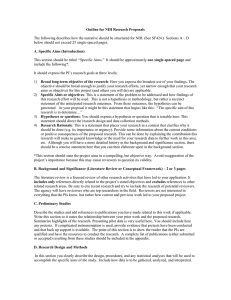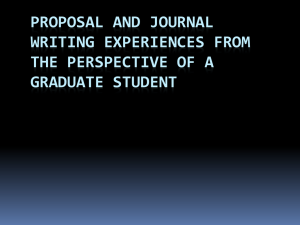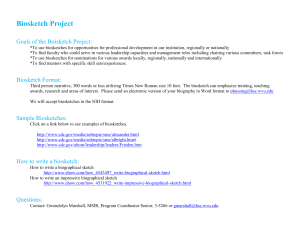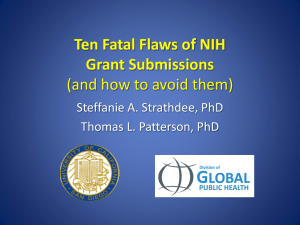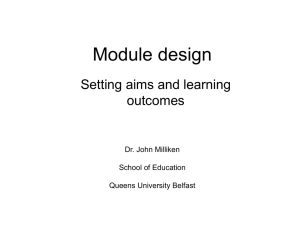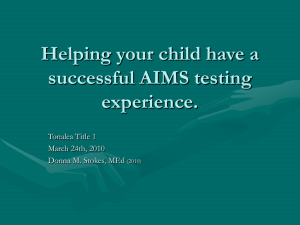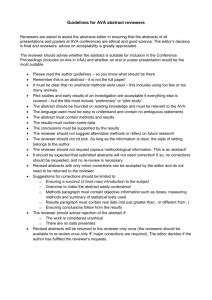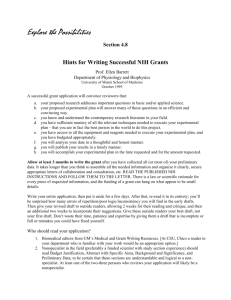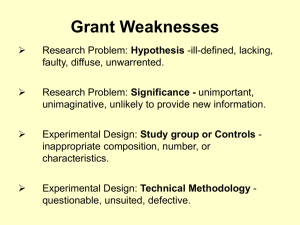slides
advertisement
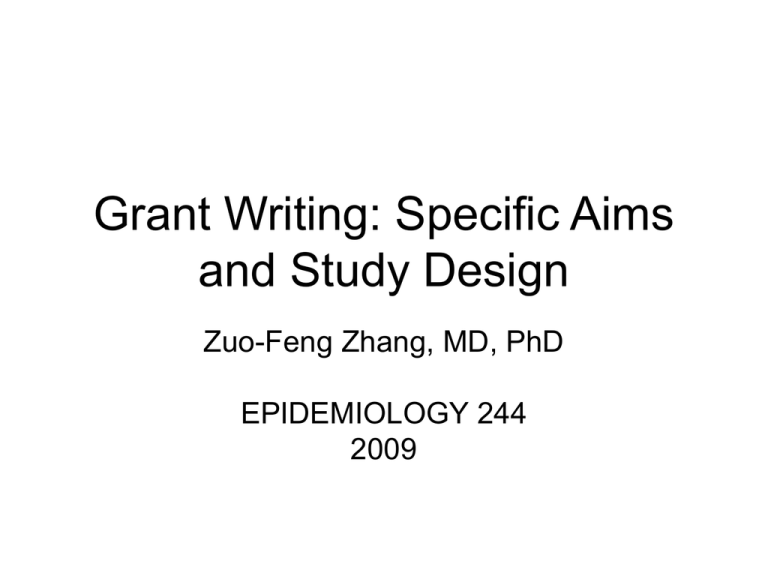
Grant Writing: Specific Aims and Study Design Zuo-Feng Zhang, MD, PhD EPIDEMIOLOGY 244 2009 Research Proposal • • • • • Abstract (5) Specific Aims (1) Background and Significance (4) Preliminary Results/Progress Report (3) Research Design (2) Specific Aims • A critical idea • Original/novel • Significant new knowledge or fill an existing knowledge gap or have significant policy implication • The first important element of the research proposal and the first impression for reviewers • A road map for your proposal Specific Aims • Introduction, including overall objectives of the research proposal and the major hypotheses to be tested. • Specific Aims: - a short sentence title - hypothesis to be tested and preliminary results supporting hypothesis - Approach to test the hypothesis - Significance of the aim Research Design • Needs to be consistent with each specific aim • Needs to describe in details the study population, data collection, quality control, experiment procedures, statistical analysis and power estimate • Strengths and limitations of the study usually follow the study design. A Strong Proposal • The operational definition of scientific merit is the priority score given to a proposal by an Initial Review Group (IRG). The pragmatic definition of a strong proposal is simply any proposal that gets funded. The strong proposal needs to be “better written”, which means easier for the reviewer to read and to understand. When Preparing an Application • Read PHS398 instructions • Consider the review criteria • Consider your primary audience - Reviewers • Never assume that reviewers “will know what you mean” • Refer to literature thoroughly and update when submitting revised application • Clearly state rationale of proposed investigation • Include well-designed tables and figures • Present an organized, lucid write-up • Obtain pre-review from other faculty at your institution Appearance: bad impression and negative reaction. • Two pounds of appendix in addition to 25 pages of text • It is 60 page long because it has the Biosketches of 20 Co-investigators. • The use of small type font with crowded pages • Typographical errors • Use of different style fonts or printers • Insert obviously photocopied pages from other proposals • Biosketch for Co-PI or Co-Investigator are not updated or obviously for other purposes Good impression and positive reaction. • All statements in proposal, including biosketch must be accurate and consistent. • The proposal is taken as an example of the products to be expected from the investigator. • Brief, a number 12 font, Double space between paragraph, 1.2 line spaces between lines. • Diagrams, figures, and paragraph titles follow specific guidelines exactly • Well organized and readable at the first glance, which make the reviewer look forward to reviewing it with pleasant anticipation. • Time table Important Sections: Budget, Biosketches, Specific Aims and abstract • Budget must be reasonable at the glance. • Biosketch must give the reviewer the impression that the investigator is absolutely capable of carrying our the study and there is a high likelihood of success. • Specific Aims section and the abstract are the most critical sections of the entire proposal. Review Criteria • Presentation must be clear; there are no typos; the science is as close as possible to state-ofthe-art; methods are supported by solid preliminary data; the problem is important; the specific hypotheses are presented and feasible tests of the hypotheses are suggested; data sought are quantitative and subject to statistical validation, enough sample size and power; the PI has proven record of success with the techniques proposed, the research is well equipped and the research group is established group and productive. Common Problems in Applications • Lack of new or original ideas • Absence of an acceptable scientific rationale • Lack of experience in the essential methodology • Questionable reasoning in experimental approach • Uncritical approach • Diffuse, superficial, or unfocused research plan • Lack of sufficient experimental detail • Lack of knowledge of published relevant work • Unrealistically large amount of work Additional Considerations • Research involving human subjects – Protection from risks – Inclusion of women, minorities, children • Animal Welfare • Biohazards • Data Sharing Plans • Appropriateness of Budget Revised Applications • 2 amendment limitation (no time limit any more) • Must have received summary statement • Cycle designed to submit every other round (this may change- see NIH Guide notice on pilot study to shorten cycle for New PIs http://grants.nih.gov/grants/guide/noticefiles/NOT-OD-06-013.html ) • Be calm and respectful of reviewers • Be responsive to reviewer’s specific critiques • Need to include Introduction and clearly mark text to show changes • Next review usually the same study section. – Continuity of review is goal. • Don’t give up! Other Grant Writing Tips • Follow format rules (don’t squeeze, don’t cheat!) – At least 11 pt font smallest allowed – No more than 15 characters per inch and 6 lines per inch – At least ½” margins • Take time – avoid sloppy errors – Give to colleagues for feedback • Write clearly for whole review committee (they are your main audience as well as judge and jury) – Well-written applications are noticed and appreciated • You are not anonymous – don’t embarrass yourself with a sloppy application.


